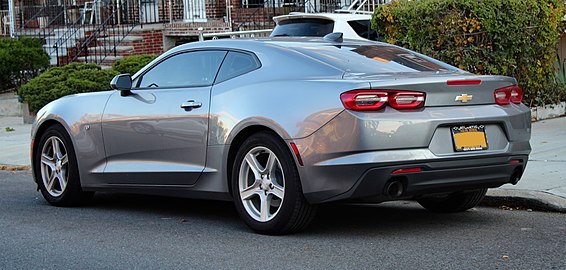| This article needs additional citations for verification. Please help improve this article by adding citations to reliable sources. Unsourced material may be challenged and removed. Find sources: "Greenhouse" car – news · newspapers · books · scholar · JSTOR (June 2021) (Learn how and when to remove this message) |

The greenhouse of a vehicle refers to the part of its body above the fender- or beltline, so called because it comprises mostly areas with glass: the windshield, side, and rear windows (or backlight), and sometimes also roof glass. These glassed areas are also known collectively as the car's daylight opening (DLO). To distinguish the greenhouse from DLO, the greenhouse is a superset which also includes the metal structures above the beltline: in general, these include the roof and all pillars separating the glass and upholding the roof.
Design and terminology
The shape and position of the greenhouse have a defining influence on the looks and functionality of the car, and are a prime means of differentiating between common body styles such as saloon/sedan, coupé, estate/wagon and hatchback. It may be a styling cue used to tie together different models from the same manufacturer; collectively, the greenhouse and other down the road graphics are used to identify and distinguish individual models. A greenhouse which tapers from bottom to top with noticeably inwardly-sloping sides is also known as having tumblehome.
The "airiness" or "openness" of a greenhouse refers to the degree to which the vehicle emulates an open-air experience by surrounding its occupants with large glass areas, also considering the height of the beltline and the width of the pillars, with an extreme example like the Popemobile being nearly all glass. Styling trends tend to cycle between "airy" greenhouses and more "closed" greenhouses; for instance, concept and production cars in the late 1960s were cited as some of the most "airy" greenhouses ever, which repeated again in the 1980s and early 1990s. In the 2000s and 2010s greenhouses became smaller because of design trends pushing a higher beltline, which at least one journalist has traced back to the introduction of the Chrysler 300 and additional safety equipment to meet tighter crash regulations.
- Automobile greenhouses
-
Lamborghini Marzal (1967): concept by Marcello Gandini with unusually low beltline
-
 BMW 02 Series (1966–77): considered airy for the abundant glass and unobscured sight-lines
BMW 02 Series (1966–77): considered airy for the abundant glass and unobscured sight-lines
-
 Ford Mustang (1971–73): high beltline, low roofline, and massive pillars
Ford Mustang (1971–73): high beltline, low roofline, and massive pillars
-
 AMC Pacer (1975–80): Noted for its relatively large, curved glass areas
AMC Pacer (1975–80): Noted for its relatively large, curved glass areas
-
 PCC streetcar (L, 1936–) & US SLRV (R, 1976–98) in Muni service: compare how window sizes have grown for transit vehicle greenhouses
PCC streetcar (L, 1936–) & US SLRV (R, 1976–98) in Muni service: compare how window sizes have grown for transit vehicle greenhouses
-
 Popemobile based on Jeep Wrangler (JK) (2015): designed to maximize visibility of Pope Francis during visit to North America
Popemobile based on Jeep Wrangler (JK) (2015): designed to maximize visibility of Pope Francis during visit to North America
-
 Honda Legend (1987-91): considered airy with low cowl, beltline, and thin pillars
Honda Legend (1987-91): considered airy with low cowl, beltline, and thin pillars
-
 BART A-series (1968–2024): low beltline, large glass areas
BART A-series (1968–2024): low beltline, large glass areas
-
 Chrysler 300 (2005–23): considered closed for its relatively high beltline and low roof
Chrysler 300 (2005–23): considered closed for its relatively high beltline and low roof
-
 Chevrolet Camaro (2016–24): considered closed for its high beltline and thick pillars
Chevrolet Camaro (2016–24): considered closed for its high beltline and thick pillars
References
- "Car Design Terminology & Jargon". cardesignonline.com. Archived from the original on 2007-02-03.
- Gustavson, Mark (1999). Custom Car Modeling. Kalmbach Publishing Company. p. 7. ISBN 978-0-89024-342-8.
- Patton, Phil (April 1, 2007). "Body Language: How to Talk the Designers' Talk". The New York Times. Retrieved 17 June 2024.
- Printz, Larry (January 20, 2010). "Speak car designers' lingo". Tampa Bay Times. Retrieved 17 June 2024.
- Rand, Dave (November 21, 2022). "Finally, I See The Forester Through The Trees". Autoweek. Retrieved 17 June 2024.
Once you get inside, suddenly it all makes sense. That tall greenhouse, slim pillars, and low cowl and beltline contribute to an open and airy cabin with visibility that no other compact crossover can match.
- Niedermeyer, Paul (October 3, 2015). "QOTD: What Car Had The Airiest Greenhouse? And The Least?". Curbside Classic. Retrieved 17 June 2024.
- Ballot, Ross (December 7, 2018). "Reversing the trend: The future of automotive design". Hooniverse. Retrieved 17 June 2024.
Then something peculiar happened, much of which can be traced back to Chrysler debuting the 300. Its styling, marked by bold angles and a high beltline, captivated the automotive world and the buying market. Cars designed in the late 1980s and early 1990s were graced with designs still bearing the tech of their times: low beltlines and big windows. Pillars were used for design and to support the roof and crumple zones, but that was it; they didn't yet have to contain airbags. Towards the late 1990s, much more focus and emphasis was put on safety. Airbags became more common and of increasing importance to buyers, and as such these technologies were incorporated more and more into automotive designs.
Further reading
- Eckermann, Erik (2001). World history of the automobile, SAE, ISBN 978-0-7680-0800-5
| Automotive design | |||||||||||||
|---|---|---|---|---|---|---|---|---|---|---|---|---|---|
| Part of a series of articles on cars | |||||||||||||
| Body |
| ||||||||||||
| Exterior equipment |
| ||||||||||||
This article about an automotive part or component is a stub. You can help Misplaced Pages by expanding it. |